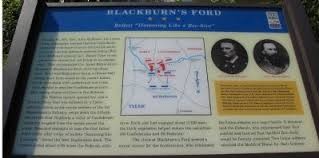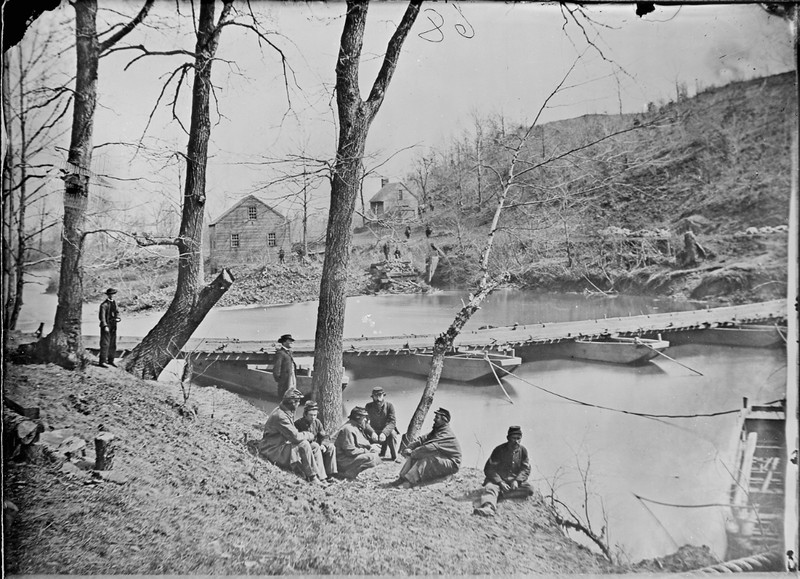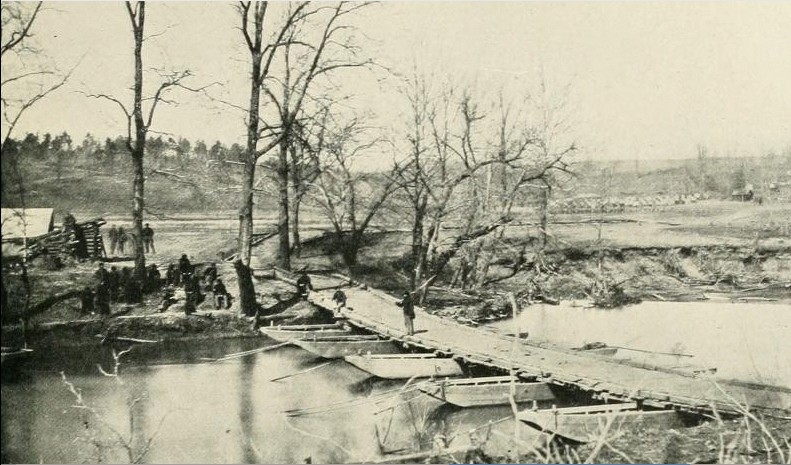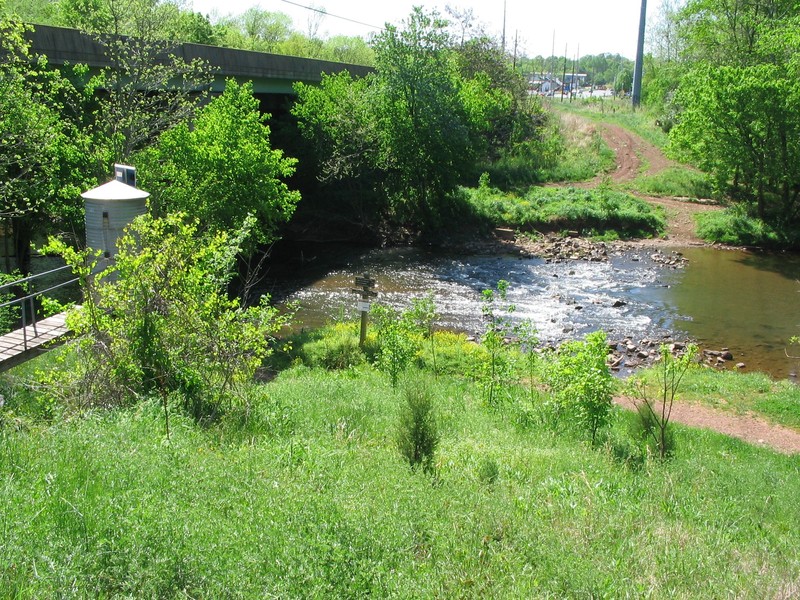Blackburn's Ford Historical Marker
Introduction
Text-to-speech Audio
Images
This historical marker is located just west of Centreville Road

Photo of Blackburn's Ford by Matthew Brady, between 1861 and 1865

Photo of Blackburn's Ford, 1862

Blackburn's Ford site today

Backstory and Context
Text-to-speech Audio
Early in the Civil War, both Union and Confederate citizens were anxious for a decisive victory. Against the more cautious and measured advice of experienced career soldiers, President Lincoln ordered General Irvin McDowell to take the strategic Manassas railroad junction. On July 17th, 1861, Confederate General P.G.T. Beauregard, to increase his defensive strength in preparation for this attack, pulled his troops back from their fortifications at Centreville and across Bull Run to the woods on the south side of the creek. Beauregard knew that the Bull Run fords were essential targets that would “bottleneck” Union forces, and he defended them accordingly. McDowell’s Federal troops moved into Centreville at 9 AM the next day without opposition. He ordered one of his commanders, General Daniel Tyler, to advance with his 1st Division and to, “Observe well the roads to Bull Run and to Warrenton; Do not bring on an engagement, but keep up the impression that we are moving on Manassas.”[3]
Tyler’s men arrived above Blackburn’s Ford later that morning. Across the river were stationed North Carolina and Virginia men under Confederate General James Longstreet, as well as seven guns from the Washington Artillery of New Orleans. Due to the thick vegetation, however, Tyler could only see the cannon battery. He brought up all of Colonel Israel Richardson’s brigade, including the 1st Massachusetts, 12th New York, and 2nd and 3rd Michigan (which were directed towards nearby Mitchell’s Ford), and his artillery. Around noon, Tyler decided to probe the ford and test the Rebel defenses; he first ordered his cannons to target the Confederate battery. Receiving no significant response, he sent a small party from the New York and Massachusetts regiments down the hill towards the creek bank. This force was harassed with scattered rifle shots from the opposite bank. Tyler then ordered the full body of New York and Massachusetts troops, a cavalry squadron, and two of his cannons to advance and open fire. Almost immediately, volleys of rifle fire poured from the Confederate positions into the Union lines. According to one account, bullets were “humming like a bee-hive.”[4] Each time the Federal troops tried to advance towards the ford, they were repulsed. The 12th New York was ultimately forced to retreat, exposing the 1st Massachusetts to withering fire. Soon after, Tyler ordered his men to pull back. His artillery continued a largely ineffective duel with their Rebel counterparts until 4 PM, when the entire Union force withdrew to Centreville. (Supposedly, a Union shell struck Wilmer McLean’s home, where Confederate General P.G.T. Beauregard was headquartered, and destroyed the General’s meal.) By the end of the battle, out of approximately 3,000 troops engaged by each side, 68 Confederate and 83 Union men had been killed or wounded. Two Union soldiers were awarded the Medal of Honor for their actions that day.
The Confederates counted the battle as a victory, even if only a moral one, since they were able to drive back the Federal troops in disarray. The Union forces were disheartened by what seemed to be an early defeat; while the information that the Confederate defenses of Bull Run were stronger than expected was useful to military planners, it was not good news to the men who would soon be attacking those positions. Blackburn’s Ford continued to be used for the rest of the First Battle of Bull Run. A Union artillery battery was stationed nearby on the Fairfax County side, and Confederate forces continued to hold the Prince William County side. On July 21st, Rebel troops under General D.R. Jones crossed to attack General Thomas Davies’s Union forces, but were driven back. At the end of the battle, Confederate troops attempted to use the ford to cut off the Union retreat, but the Federal troops had already made it back to Centreville.
On July 20th, 1861, a short truce was called to allow Union troops to carry their dead off of the field. Six of these men, all from the 1st Massachusetts, were buried together south of Centreville. These graves were lost to history until 1994, when they were located by an amateur metal detector. An archaeological excavation soon followed, and the six sets of remains were reinterred in the Massachusetts National Cemetery in 2006.
Sources
1) Ambrose, Kevin. The forgotten graves of soldiers killed 157 years ago, during the oppressively hot Battle of Blackburn's Ford, The Washington Post. July 18th 2018. Accessed July 14th 2020. https://www.washingtonpost.com/news/capital-weather-gang/wp/2018/07/18/the-forgotten-graves-of-soldiers-killed-157-years-ago-during-the-oppressively-hot-battle-of-Blackburns-ford/.
2) Early, Jubal A. Report of Col. Jubal A. Early, commanding Sixth Brigade, First Corps, Army of the Potomac; 1st Battle of Bull Run Confederate Order of Battle; The Battle of Bull Run (1st Manassas) (July 21, 1861), Shotgun's Home of the American Civil War. Accessed July 14th 2020. https://civilwarhome.com/earlybullrunor.htm.
3) The Skirmish at Blackburns Ford; Manassas National Battlefield Park Virginia, National Park Service. April 10th 2015. Accessed July 14th 2020. https://www.nps.gov/mana/learn/historyculture/the-skirmish-at-Blackburns-ford.htm.
4) Swain, Craig. Blackburn’s Ford: Bullets “Humming Like a Bee-hive”, HMdb.org. July 18th 2018. Accessed July 14th 2020. https://www.hmdb.org/m.asp?m=42643.
5) Swain, Craig. Blackburn’s Ford: Guarding the Fords, HMdb.org. July 18th 2018. Accessed July 14th 2020. https://www.hmdb.org/m.asp?m=42644.
Public Domain - National Archives via Wikimedia Commons (https://commons.wikimedia.org/wiki/File:Blackburn%27s_Ford_-_Brady.png)
Public Domain - The Photographic History of The Civil War in Ten Volumes: Volume One, The Opening Battles via Wikipedia (https://en.wikipedia.org/wiki/File:Blackburn%27s_Ford.png)
By Craig Swain on HMdb.org (https://www.hmdb.org/PhotoFullSize.asp?PhotoID=6344)
